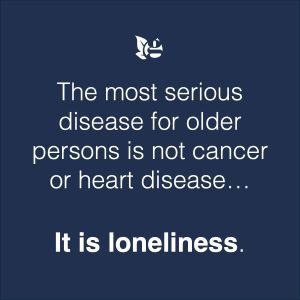12 Mar Loneliness


Paul A. Goldberg MPH, DC, DACBN, DCBCN
Founder and Consultant to The Goldberg Tener Clinic
Chronic Disease Reversal
We are not alone in the world yet many feel that way. It is easier to appreciate what happens when we are cut off from water, food, sunlight or air than the ramifications of long-term loneliness. A lack of companionship, however, can lead to a weakening of our health and promote the development of chronic illness as certainly as a poor diet. It is something that health care practitioners cannot afford to overlook nor something which patients can afford to ignore.
The person who tries to live alone will not succeed as a human being. His heart withers if it does not answer another heart. His mind shrinks away if he hears only the echoes of his own thoughts and finds no other inspiration.
Pearl S. Buck
Man does not live by bread alone. Even with the addition of sunlight, air and water we do not have the recipe for a whole life. Humans, like most animals, are not solitary creatures. We need “significant others”. We have a need to relate to someone outside of ourselves in a meaningful way.
My mentor, R.J. Cheatham, whose Hygienic Retreat Center I was the Director of in the mid 1970’s, once posed the following question to me…
“What is the greatest deficiency in the United States?”
Dr. Cheatham was a scholarly man with a deep knowledge of health, hygiene and nutrition. Through natural methods he survived a deadly form of cancer for over thirty years. I raced through the recesses of my mind for an answer… a lack of Sunlight? Insufficient Vitamin C? “No”, he responded, “the greatest deficiency is a a lack of companionship.” It is ironic that in a nation of 300 million people, with congested cities and crowded highways, that people should feel so alone. Fewer people live in isolated rural areas as increasing numbers have migrated to the most concentrated population areas along the coastlines and in the big cities. Amidst all the hub-bub, the maddening crowds and rush hour traffic are tens of millions of painfully lonely people… not always alone but terribly lonely.
 The U.S. social structure and population distribution have changed dramatically. Within the past decade alone, the number of single parent households has risen by 21% while the number of people living by themselves has increased by 20%.[1] At the same time, a larger percentage of the population is alone by the fact that they are aged, their children have moved away and they have outlived their spouses. “The most serious disease for older persons is not cancer or heart disease… it is loneliness.” [2] As the percentage of elderly people in our population increases and lives alone, the chances that their social needs are being met decreases and the prevalence of loneliness increases. Epidemiological research has shown that loneliness is a significant risk factor for a wide range of health problems among the patients we see reflected in both increased morbidity and mortality.[3]
The U.S. social structure and population distribution have changed dramatically. Within the past decade alone, the number of single parent households has risen by 21% while the number of people living by themselves has increased by 20%.[1] At the same time, a larger percentage of the population is alone by the fact that they are aged, their children have moved away and they have outlived their spouses. “The most serious disease for older persons is not cancer or heart disease… it is loneliness.” [2] As the percentage of elderly people in our population increases and lives alone, the chances that their social needs are being met decreases and the prevalence of loneliness increases. Epidemiological research has shown that loneliness is a significant risk factor for a wide range of health problems among the patients we see reflected in both increased morbidity and mortality.[3]
Academic studies document the ill effects of loneliness but common sense suffices to come to the same conclusions that formal studies have reinforced. Imagine yourself in a world where there was no one else but yourself, where you have nobody to share your thoughts with, no one with whom to share good and bad experiences. It’s just you. It might be O.K for a day perhaps, but in short order your stomach would knot up, you would begin feeling anxious and a deep depression would work its way into your soul.
The most severe punishment allowed in prisons is that of solitary confinement and there are strict guidelines for its implementation. Solitary confinement involves placing the prisoner in a small room where he or she is denied human contact. Prolonged deprivation of this type produces symptoms similar to mental illnesses. Frank Darabont’s movie, The Shawshank Redemption, depicted this harsh form of punishment considered unduly severe by many. The Count of Monte Cristo, by Alexander Dubos, depicted the anguish of falsely accused Edmond Dantes who was placed in a dingy cell with no human contact and came close to going entirely mad. When after many years he contacted fellow prisoner Abbe Faria in his attempt to escape, the joy he felt in having another human to relate with produced nothing less than a state of emotional ecstasy.
Studies have repeatedly shown the damage that results from long term social isolation. Dr. Stuart Grassian’s paper, The Psychopathological Effects of Solitary Confinement [4], reported that social isolation resulted in:
- Generalized hyper-sensitivity to external stimuli.
- Perceptual distortions, hallucinations, and derealization experiences.
- Affective disturbances.
- Disturbances of thought content including symptoms of paranoia and problems with impulse control.
Dr. Grassian concluded that “present observations strongly suggest that the use of solitary confinement carries major psychiatric risks.”
Experiments performed [5] on non-human primates have demonstrated that when these unfortunate animals are placed into social isolation they begin to engage in withdrawal, depression, self-destructive behaviors and eventually, despite being provided essentials such as food, water and air, become so ill that death can occur. Animals used for research are often kept in isolation for their entire miserable lives as are those used for agricultural purposes. These animals frequently engage in severe self-destructive behaviors because of their inability to socialize with others.
The effects of loneliness are destructive and pervasive. Susan Duncan, RN writes on its physiological effects in producing chronic illness.
“Loneliness is a stress – like pain, injury/loss, grief, fear, fatigue and exhaustion. Loneliness can be traumatic. Physiologically, loneliness can trigger the same stress response as a broken leg. This causes our bodies to alter the production of hormones, which in turn alters the function of many other systems in the body. Ultimately, this can affect every cell in our bodies. Stress like this has been implicated in contributing to the origin or severity of diseases such as cardiovascular disease (including strokes, migraines, and heart attacks), gastrointestinal disorders (including ulcers), autoimmune disorders, asthma, and many other illnesses.”[6]
Ms. Duncan cites the work of Dr. James Lynch and his book, The Broken Heart: the Medical Consequences of Loneliness.[7] Dr. Lynch notes that:
“The lack of human companionship, the sudden loss of love, and chronic human loneliness are significant contributors to serious disease (including cardiovascular disease) and premature death.”
Humans are social animals – for millions of years as hunters and gatherers we survived by being in close knit groups. That same need to have meaningful relationships with others continues today.
The occasional patient believes they do not need others. Often times this comes out of feelings of long-term rejection or due to a social awkwardness that has made interacting with others uncomfortable even though they may sorely desire meaningful companionship. Our bodies, however, are not self-contained. Our physiology is significantly regulated by our interactions with those who are external to us. The pain we feel when we are lonely can be agonizing and reminds us of our need for others.
All of us want to be acknowledged and recognized… to be reminded that we are not in this difficult, worldly dilemma alone. We want to share the pleasures of life with each other. The joys of a beautiful sunset, a delicious meal or a funny joke all become trivialized when there is no one to share them with.
Go to a carnival and view the couples walking hand in hand. Groups of friends and family buzzing with excitement, turning one to the next smiling and joking. Take a stroll on the beach and find friends throwing frisbees, a father building sand castles with his children, a mother supervising her kids splashing each other in the water. Do you see anyone alone at any of these or other events who appear to be having a great time by themselves with no one to share the good times with?
 Dogs are like us in terms of their need for companionship and love. When your dog is by herself she likely looks sad. Walk in the room and her eyes light up. She runs to greet you with her tail wagging furiously. She acts as if she has been brought back to life. Leave her alone again and she sighs, lays herself back down on the floor and again sadly awaits for your return.
Dogs are like us in terms of their need for companionship and love. When your dog is by herself she likely looks sad. Walk in the room and her eyes light up. She runs to greet you with her tail wagging furiously. She acts as if she has been brought back to life. Leave her alone again and she sighs, lays herself back down on the floor and again sadly awaits for your return.
There might be the rare patient who gets along OK entirely on his or her own without others… but I have not met that person yet in thirty years of practice. We are simply not wired that way.
Balancing the equation is our need to spend time alone in reflection which can also be an un-met need for many patients. There are stories of men and women who have in their quest for “spiritual enlightenment” deliberately sought out periods of solitude. Jesus and Moses went into solitude for forty days to reflect and make important decisions. Clearly the mind works differently when one is alone. Some people deliberately set aside time to be alone to re-charge and allow the dust in their minds to settle. Being alone for reasonable periods does not have to entail loneliness. A period of solitude gives us the opportunity to face our internal chaos and allow our internal mechanisms an opportunity to take a sabbatical from society’s constant chatter, thereby fostering personal growth and renewal. No one can deny that other people can be annoying at times. Who among us at one time or another has not wanted to get away from the maddening crowd? Getting away on our own from time to time is important. It gives us a chance to be with our own thoughts and feelings to “sort things out”. Thomas Fuller said, “Better be alone than in bad company”.[8] In time, however, loneliness sets in and we want to and need to re-join the flock.[9]
“That Special Someone”
Pair bonding is a normal state of affairs for humans that includes but also extends beyond sexual needs alone. We desire someone that will be our “other half”. This need has been programmed in us over the course of many thousands of years and has resulted in the institution of marriage which is reinforced by both religious and legal systems. The institution of marriage has particularly served the interests of children whose parents are legally bound with each other. Married people generally live longer than those that are unmarried and some people can attest to their own wedded bliss… although not everyone.
That “Not So Special” Someone Anymore
Despite the sanctity and legal support that has been given to marriage as an institution, many find it difficult to remain bonded for life to one person, continuing their marriages due to children, social pressures, finances and other reasons apart from “matrimonial bliss”. Marriage as an institution shows no sign of becoming extinct yet people are divorcing in record numbers.[10] The saying about women that “you can’t live with them and you can’t live without them” may be appropriate from the male vantage point. Women have their own view. A female patient once commented to me, with a note of cynicism, that “men are like babies…they are cute at first but you soon get tired of cleaning up their crap!”
Despite the problems marriage can present, the breaking of that bond frequently has disastrous effects on a patient’s health. Divorce can be a severe physical/emotional stress that practitioners often witness.
From my own observations with patients I have counseled with, it is prudent to enter marriage with caution and then once the die is cast, to work to preserve it with vigor before seeking its dissolution.
In the Holmes and Rahe Social Readjustment Scale [11], a measurement used to reflect the individual’s likelihood of developing serious illness from a specific life event, divorce, out of forty life events, is listed as the number two most destructive stress, second only to the death of a spouse (or child). Numerous stories of the loss of a spouse, followed by illness or death soon after in the surviving spouse, are well documented. The devastating effects of a spouse’s death have no easy solution. It is best to allow a reasonable period of grieving and avoid prolonged isolation. This painful situation is faced by most people during their lives. Survival and a new chapter of life afterwards are possible. The same is true of divorce.
Divorce may be inevitable for some as there are many who simply have made a bad choice in a mate. Too often hormones and fanciful visions of romance allow mistakes to occur. Many breakups emanate from having unrealistic expectations of marriage and a failure to appreciate that matrimony requires an ongoing commitment and compromises by both parties. Our society has so glamorized courtship, engagement and weddings as to fashion an unattainable fairy tale version of marriage. I have counseled engaged persons, women and men, to take a good look at their betrothed before they go to bed on their wedding night because in the morning, they will find a stranger lying next to them. Our expectations of marriage often belong more in the realm of fantasy than in the world of reality. The person underneath the makeup, expensive suit, fast car, soothing voice and other accoutrements can be much different after the marriage than during the courtship.
Marriage should entail an emotional, physical and social commitment. Much of marriage’s initial attraction is the sexual intimacy it affords, and many believe that with this physical involvement a corresponding communication bridge will be built. Sexual intimacy alone, however, will not seal the future of a marriage nor guarantee eliminating loneliness. If marriage is not accompanied by the ability of both parties to communicate constructively devoid of hurtful weapons such as sarcasm, cynicism and deceit, sexual contact alone can become a hollow experience accompanied by only brief, superficial pleasure.
The unrealistic expectations many have of marriage can leave one with a profound feeling of wanting once we find they are not attainable. Viewing other couples who appear to be doing well and the romanticized versions of marriage which bombard us via movies, we begin to feel we’ve made a terrible error. The only answer appears to be improving the relationship or dissolving it. The first is a good idea to be employed on an ongoing basis in all marriages. The second may be necessary but should be reserved as a last resort as its health repercussions can reverberate through both parties. It should also be understood that marriage has the potential to enhance one’s life but it is not a means to solve personal issues. It is also true that in a marriage that is worked on diligently with patience, understanding, and ongoing effort made towards good communication, that being married can make the good things in life more than twice as good and the hardships and disappointments in life less than half as bad.
Want To Live Long? Get Some Friends!
 Women generally outlive men. One reason given for this phenomenon is that women are more likely to develop mutual assistance pacts to support each other with compared to men, allowing females to retain significant bonds even after the death of a spouse.
Women generally outlive men. One reason given for this phenomenon is that women are more likely to develop mutual assistance pacts to support each other with compared to men, allowing females to retain significant bonds even after the death of a spouse.
Having ongoing contacts with family and/or friends is a trait found in common with most people surviving into old age. The mother of a patient of mine had recently passed her 97th birthday. I noted how sociable she was with everybody around her. Her son told me that she kept herself busy with friends, particularly at church. I asked her if there was a secret to living so many years. She responded, “it’s easy dear… just don’t die”, but I knew her congenial attitude and the way she easily won friends played a role.
Mrs. Smith
Many years ago, I practiced in a small town in North Georgia. One day, a woman of seventy seven years, whom I will refer to as “Mrs. Smith”, came into the office complaining of low back and hip pain and fatigue. Physical examination, basic laboratory studies and x-rays revealed little amiss other than some minor musculoskeletal imbalances for which I utilized gentle spinal adjustments, physiotherapy and dietary modifications. After the third visit, I asked Mrs. Smith how she was feeling. She inquired as to why I wanted to know. I replied that since signs of objective improvement were apparent, I felt she was near completion of her care with me. If she was feeling sufficient improvement, I said we could dismiss her. She responded in a non-critical manner that she “wasn’t feeling better yet” and that I “should continue working with her.”
Considering her ongoing discomforts I conducted additional laboratory studies, all of which came back normal. Two weeks later, Mrs. Smith responded to my inquiries that she was still no better. I suggested referring her out to another doctor for a second opinion, but she insisted that she continue her care with me, but perhaps, she added, I should see her “more frequently”.
At her following visit, I took Mrs. Smith to my office and suggested we talk for a spell. I asked her additional questions about her background. She had grown up in Alabama and had married her husband at seventeen. They had lived together in Alabama for sixty years. She recounted the “wonderful life” they had together. A year ago, they had moved from Alabama to the little town in which I practiced, to a home left to them by a relative. A couple months later Mr. Smith had a stroke and died leaving Mrs. Smith alone in a town where she knew no one. “You must miss him terribly” I said, at which point she began to sob uncontrollably. I allowed her a chance to cry and comforted her as best I could. Before leaving the office, she made an appointment to come back for another office visit. I reflected on what a dummy I had been. I had missed the cause of her problem altogether. She was lonely in the present and fearful of a desperately lonely future, in a place where she knew no one.
I took it upon myself to call another lady, “Mrs. Baker”, who ran a senior citizens club in town that met twice per month for lunch. I asked her to come and meet Mrs. Smith at my office the following week. I had scheduled her appointment to coincide with the next luncheon meeting of the senior citizens group. Mrs. Baker came to my office and I introduced the two. Mrs. Baker invited Mrs. Smith to join her in going to the luncheon meeting which Mrs. Smith accepted.
Mrs. Smith had another appointment with me the next week but didn’t show up. Three weeks later, however, I walked into the reception area to find her sitting there with an elderly gentleman. “Mrs. Smith”, I exclaimed, “how good to see you! Did you come in to receive care for your back and hip?” She looked a bit puzzled for a second and responded cheerfully. “Oh no, Dr. Goldberg, funny thing, they have not been bothering me at all. I just wanted to introduce you to Clyde!” She had met Clyde, a widower, at the luncheon Mrs. Baker had taken her to. The two of them hit it off and had been seeing each other regularly.
Mrs. Smith never had another episode of her back and hip pain nor complained of fatigue again during the following five years I continued practicing in that little town. She did, however, stop in, on occasion, to say hello. She and Clyde continued to see each other and eventually got married at age 78 for her and 82 for him (they never had any kids though). Mrs. Smith referred a number of patients to me telling them that Dr. Goldberg knows how to “get rid of fatigue, hip and back pains really good!” Loneliness, however, was the problem and in her case, Clyde had been the remedy.
More Articles from The Goldberg Tener Clinic
1) Reversing Autoimmune Disorders
2) Reversing Chronic Skin Conditions
3) An Effective, Causal Based Approach to Digestive Problems
4) Reversing Rheumatoid Arthritis and other Rheumatoid Conditions
5) Reversing Thyroid Conditions
6) Small Intestinal Bacterial Overgrowth (SIBO): A Symptom of Impaired Health
7) Irritable Bowel Syndrome: A Meaningless Diagnosis
8) The Facade of Functional and Alternative Medicine
9) An Effective, Comprehensive Approach to Reversing Allergies
10) You have been misled… the way to lose weight is NOT trying to lose weight.
11) Click here to see our full library of articles.
References
[1] Hobbs, F., and Stoops, N. (2002) Demographic Trends in the 20th Century (US Census Bureau, Census 2000 Special Reports, Series CENSR-4). Washington, DC: U.S. Government Printing Office.
[2] Pets For The Elderly Foundation: http://www.petsfortheelderly.org/index.htm
[3] Seeman, T.E. (2000). Health promoting effects of friends and family on health outcomes in older adults. American Journal of Health Promotion, 14, 362-370
[4] Grassian, Stuart M.D. The Psychopathological Effects of Solitary Confinement American Journal of Psychiatry, November 1983
[5] The author strongly condemns these inhumane experiments inflicted on sentient creatures.
[6] Duncan, Susan, R.N.: “Loneliness: A Health Hazard of Modern Times” Interactions, Vol. 13 #1, 1995, pp. 5-6, 8-9.
[7] Lynch, James J., The Broken Heart: the Medical Consequences of Loneliness (N.Y., Basic Books, Inc., 1979), p. 181. Ibid., Chapter 5.
[8] Fuller, Thomas, 1608–61, English clergyman and author.
[9] Some people prefer never to be alone and fear it greatly, experiencing a sense of uneasiness when by themselves and the need to turn on the television, radio, or find other means of distraction. Some would sooner face a hostile crowd than be in solitude and face what might be a troubled heart.
[10] Half of all marriages in the U.S. now terminate in divorce.
[11] Holmes TH & Rahe, RH (1967) The Social Readjustment Scale, Journal of Psychosomatic Research, 11, 213-218





No Comments